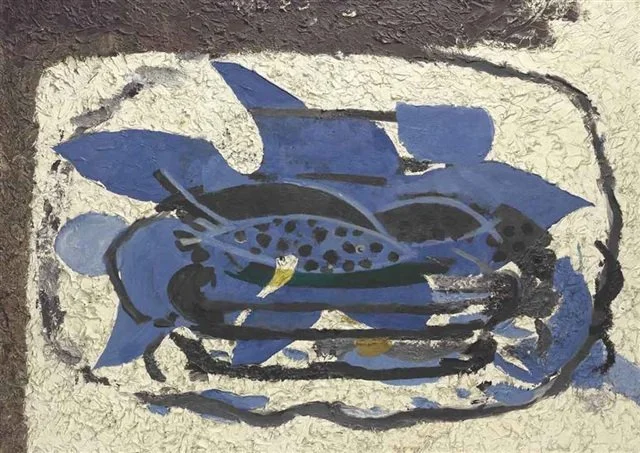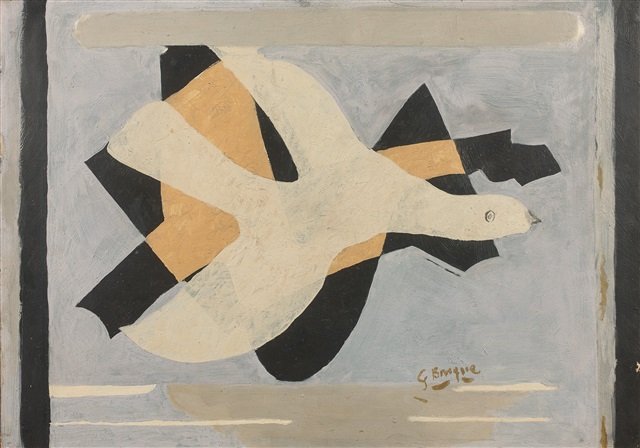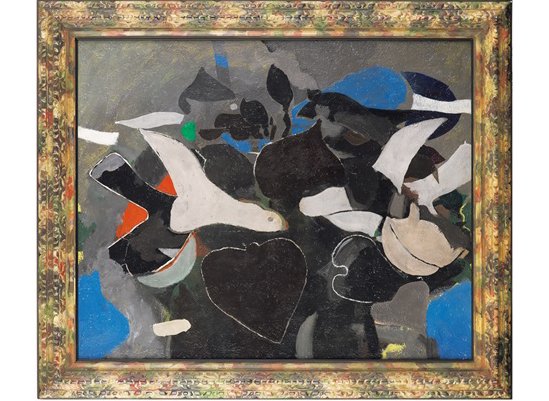GEORGES BRAQUE,
LE CHAR (CONDUCTRICE III), 1934
GEORGES BRAQUE
Le Char (conductrice III)
signed, lower right GBRAQUE
oil and charcoal on canvas
10.6 x 20.4 in. / 23 x 51.7 cm
painted in 1934
Provenance:
● Estate of the artist
● Private collection, France
● Private collection, Belgium (circa 1965)
● Christie's New York: Saturday, May 14, 2022 [Lot 00901]
Impressionist and Modern Works on Paper and Day Sale
COMPARATIVE PAST AUCTIONS
-
Georges Braque, L'aquarium bleu
oil on board laid down on canvas
30.2 x 41.7 in / 76.5 x 106.4 cm
painted in 1960-1962
PROPERTY FROM AN IMPORTANT COLLECTION
Sale of : Christie's New York: Friday, May 15, 2015 [Lot 01214]
Impressionist and Modern Day Sale including Property from the John C. Whitehead Collection
Estimate : 300,000 - 400,000 USD
Sold For : 725,000 USD PremiumProvenance :
- Claude Laurens, Paris
- Galerie Louise Leiris, Paris (by 1987)
- Galerie Beyeler, Basel
- John C. Whitehead Collection
- Acquired from the above by the present owner, August 1988
source : ARTNET.COM -
Georges Braque, L'oiseau et son ombre
oil on cradled cardboard; signed lower right
22.4 x 1.5 in / 57 x 80 cm
painted in 1959
PROPERTY FROM PAUL LOMBARD COLLECTION
Sale of : Artcurial, Tuesday, October 10, 2017 [Lot 00088]
Estimate : 200,000 - 300,000 EUR (236,127 - 354,191 USD)
Sold For : 629,000 EUR Premium (742,621 USD)
Provenance :
- Atelier de l'artiste
- Marguerite et Aimé Maeght, Paris
- Adrien Maeght, Paris
- Collection Paul Lombard
source : ARTNET.COM -
Georges Braque, Les oiseaux
oil on canvas, framed
34.8 x 42.2 in / 88.5 x 107.3 cm
painted in 1957
PROPERTY FROM AN IMPORTANT COLLECTION
Sale of : iART CO.,LTD, Saturday, September 28, 2019 [Lot 00083] Autumn Auction
Estimate : 70,000,000 - 120,000,000 JPY (648,448 - 1,111,625 USD)
Sold For : 70,000,000 JPY Hammer (648,448 USD)
Provenance :
- Galerie Louise Leiris (Paris)
- Lake Collection(Japan)
- Private collection (Japan)
source : ARTNET.COM
source : ARTNET.COM
DOCUMENTATION
GEORGES BRAQUE, Le Char (conductrice III), 1934
This 1934 piece speaks directly to an earlier set of Braque’s works, completed between 1932 and 1935. ‘In 1931, vendor and writer, Ambroise Volland, commissioned Braque to illustrate a book of his choosing. Braque suggested one of his preferred works, Theogony, 7th century BC Greek poet Hesiod’s grand-oeuvre. The account, dedicated to the origins of the universe and the gods, is among Greek mythology’s apex works. Between 1932 and 1935, Braque produced a set of sixteen etchings, ultimately published by Maeght in 1955.’1.
This canvas was composed using oils and charcoal; it depicts a horse and chariot moving with intent. Although the frame of reference is that of Antiquity, the work’s style is very modern: simplified, abstract forms, little in the way of light-dark contrast (which would have served to play with volume) and more or less uniform areas of green, blue and brown. The lines – used for contouring and to represent the reins – highlight the relationship between the background and the ‘figures’. In addition, the pale-blue background (suggestive of sea or sky) makes the figures stand out very clearly within the painting.
There is one other artistic aspect of this work to notice: the oval frame surrounding the painting is itself painted on. Braque more or less uniformly applies this section around the central image; it is, therefore, not a frame but plays on – or in any case imitates – the idea of a frame. In this respect, we are very clearly in the realm of Modern Art: Braque is not afraid to integrate the frame into the painting, inverting our expectation of it. As a result, we do not know if it is the painting that becomes the frame or the frame that becomes (part of) the painting. The oval demarcates the painting, replacing the physical object of a frame and functioning as an outline. In so doing, it becomes a founding part of the work’s own autonomy. This painted, oval area is, in effect, playing the role of frame: it is both a human construct (the viewer understands that it is supposed to ‘be the frame’) and a facilitator for human viewing (it clarifies the difference between the part that is the image and the part that is outside of that). It is thanks to this outlining area that we understand that what we are seeing is a ‘precious’ object that needs protecting – a painting.
Georges Braque’s Post Cubist Masterpieces, Anthem Edition, 2024.




